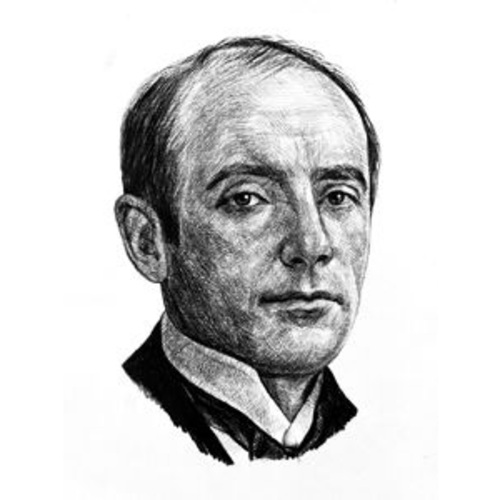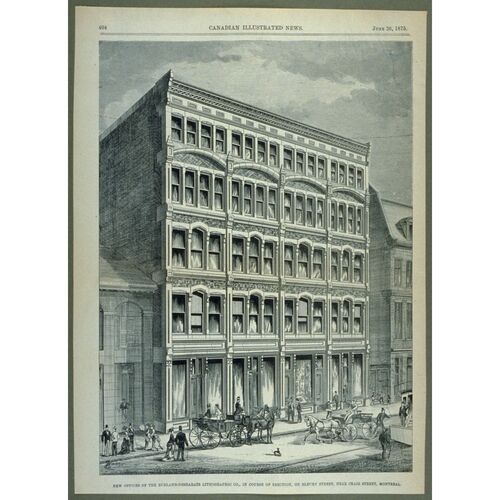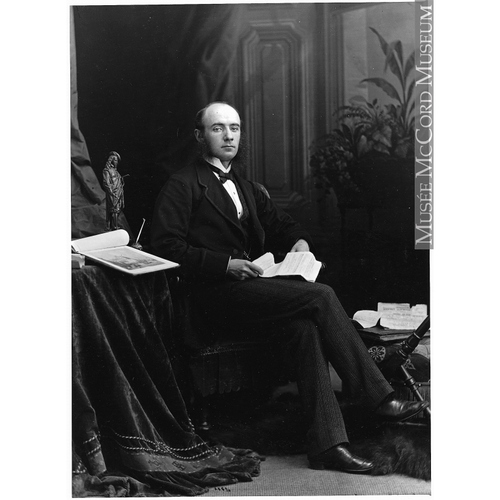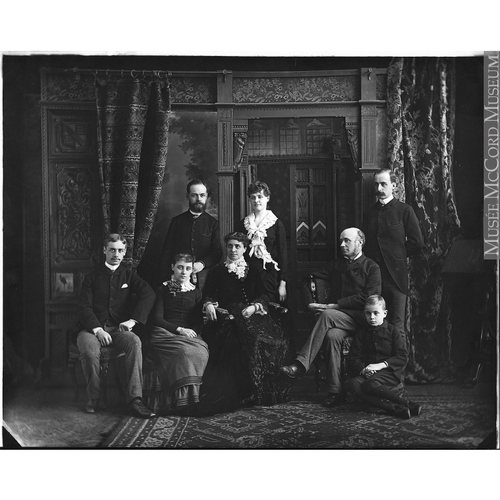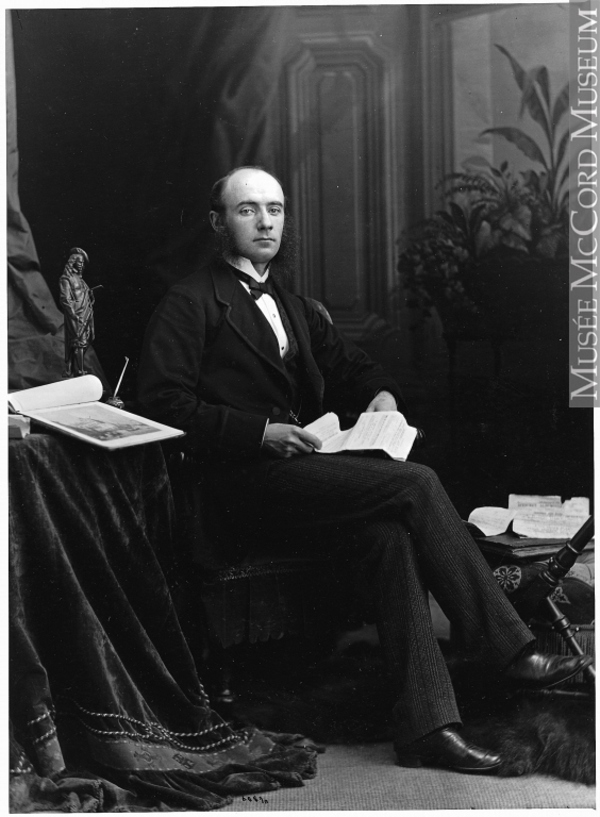
Source: Link
DESBARATS, GEORGE-ÉDOUARD (baptized George-Édouard-Amable, also called George Edward), lawyer, printer, inventor, publisher, school administrator, and militia officer; b. 5 April 1838 at Quebec, son of George-Paschal Desbarats* and Henriette Dionne; d. 18 Feb. 1893 in Montreal.
George-Édouard Desbarats’s mother died when he was a year old and he was placed in the care of his grandfather, Amable Dionne*. In 1846 his father sent him to Holy Cross College in Worcester, Mass. Although he was far from his family, the five years he spent at school there seem to have been happy. In 1852 he enrolled at the Collège Sainte-Marie in Montreal for the final part of his secondary studies (Rhetoric and the two-year Philosophy program). Having completed his classical education at the age of 17, which was then considered young, he returned to his native city and began to study law at the Université Laval. At the same time he became a clerk in the legal firm of his uncle Jean-Thomas Taschereau, who in November 1858 gave him a certificate of competence to practise law. Undecided about whether to become a lawyer or to go into business with his father, he went on a trip to Europe. On his return, he took the faculty of law examinations, and was called to the bar of Lower Canada on 2 May 1859. The following year, on 30 April 1860, he married Lucianne (Lucie-Anne) Bossé, the eldest daughter of Joseph-Noël Bossé, later a senator and judge.
Although he was offered a position in the firm of Toussaint-Antoine-Rodolphe Laflamme, Desbarats chose to begin working with his father, who was queen’s printer, in the firm of Desbarats et Derbishire. Over the next five years he was involved in the printing business and was closely connected with a small group of Quebec writers who gravitated around Le Foyer canadien, a periodical which his father backed as printer and publisher. During this period the Desbarats published more than a dozen literary, historical, religious, biographical, and scientific works, for example, in 1864, the second edition of Les anciens Canadiens by Philippe-Joseph Aubert* de Gaspé, Histoire de la mère Marie-de-l’Incarnation . . . by Abbé Henri-Raymond Casgrain*, and Énumération des genres de plantes de la flore du Canada . . . by Louis-Ovide Brunet*.
Desbarats inherited his father’s business upon his death in 1864. In 1865 he and his partner Malcolm Cameron*, who had replaced Stewart Derbishire* after his death in 1863 and who now held the position of queen’s printer, followed the government to Ottawa. They set up their printing-shop on the ground floor of a building erected by the elder Desbarats on Sparks Street and rented out rooms on its two upper floors. At the same time Desbarats settled his family in Chapel Court, the beautiful house he had built at the corner of Chapel Street and Daly Avenue. The young firm of Desbarats and Cameron seemed to have good prospects, and Desbarats and his wife lived in grand style in the new capital of the Province of Canada, which helped to assuage her longing for Quebec.
The year 1868 was, however, marked by a tragedy that would affect Desbarats personally: Thomas D’Arcy McGee* was assassinated in the doorway of the rooming-house on Sparks Street in the early hours of 7 April. Although Desbarats received several threats, he put up a plaque on the wall of the building to honour the memory of his friend and tenant. On the night of 20 Jan. 1869, while the Desbarats were giving a fancy-dress ball at their residence, the building on Sparks Street was set on fire and destroyed, as were the printing equipment on the premises and the finished copies, lithographic plates, and illustrations of the first edition of the Œuvres de Champlain, edited by Abbé Charles-Honoré Laverdière*. Fortunately Laverdière had kept a set of proofs at Quebec. Far from becoming disheartened, Desbarats was able in 1870 to publish the six-volume work at Quebec, where five years earlier he had established a printer, a press, and the necessary equipment. Desbarats also had numerous commitments in Montreal, having gone into partnership some years before with engraver William Augustus Leggo* Jr and set up a business at 319 Rue Saint-Antoine. In addition, on 1 Oct. 1869 he accepted the offer of the prime minister, Sir John A. Macdonald, to become the first official printer of Canada. The size of his printing and publishing enterprises in Montreal and Quebec made it impossible for him to carry on for long in Ottawa, especially since he was now neglecting his family. Hoping that his sons would one day take over the printing business, he resigned his post in the spring of 1870, sold Chapel Court to Sandford Fleming*, and invested the $10,000 from its sale in the Canadian Illustrated News (Montreal), which had been launched on 30 Oct. 1869. He took his family to Montreal and could then give free rein to his printing and publishing ventures.
It was undoubtedly at Quebec that Desbarats had met Leggo, who worked in the atelier of his father, William Augustus Leggo, before going to complete his training in Montreal and Boston. On his return to Quebec, Leggo had established himself as a copper and steel engraver. On 12 Dec. 1864 the two partners put in their first joint patent application as “engravers, lithographers, and electrotypists” for a new and useful technique they had invented, leggotype. This method, a “photo-engraving process for reproducing line drawings or black and white engravings,” followed on Paul Pretsche’s work in electrotyping and Alphonse Poitevin’s work in heliography. In June 1869 Leggo registered a patent for granulated photography, and then set up Leggo and Company in Montreal in July. When Desbarats launched the Canadian Illustrated News at the end of October, the paper had a full-page photo-mechanical engraving handled by Leggo. This use “on a commercial basis [of] a means of photo-mechanical reproduction compatible with typography” was “the first worldwide.” Beginning the following year Desbarats would reprint the Œuvres de Champlain in a facsimile edition using leggotype. On 1 Jan. 1870 he began publication of L’Opinion publique, a 12-page weekly carrying virtually the same illustrations as its sister publication, the Canadian Illustrated News. The photographic studios of William Notman of Montreal and the late Jules-Isaïe Benoit*, dit Livernois, of Quebec were mainly responsible for the pictures. The two magazines were none the less independent, since the Canadian Illustrated News was edited by Alexander Robinson and L’Opinion publique by Joseph-Alfred Mousseau* and Laurent-Olivier David*. From 17 September both were illustrated with lithographs prepared in the printing-shops on Rue Saint-Antoine, which were then equipped with a combination of services that made Desbarats’s firm one of the most modern in Canada. This use of lithography was still comparatively rare, a fact recognized in Europe. Thus Desbarats and Leggo were responsible for three innovations in the printing of periodicals: leggotype, granulated photography, and photolithography. These together formed an integral part of the technical advances made in mass communications during the 19th century.
Desbarats and Leggo had even more ambitious plans. After an agreement with Ferdinand Gagnon*, in November 1870 L’Opinion publique took over the Worcester paper L’Étendard national as its Franco-American edition. That year the two inventors also planned to publish newspapers simultaneously in different cities, using leggotype facsimiles and telegraphic retransmission, and to produce a de luxe edition, ordinarily costing ten dollars, for the modest sum of ten cents, since a single leggotype plate could print 15,000 copies. Although these plans did not materialize, others did come to fruition. In 1870 Desbarats founded Hearthstone, a Montreal literary weekly edited by John Arthur Phillips. The following year he bought the Dominion Telegraph Institute, which trained many Canadian and American telegraphers, and he was its director for two years. Moreover, he had set up a telegraph line connecting his office on Place d’Armes with his printing-shop on Rue Saint-Antoine. In Montreal he launched the Canadian Medical and Surgical Journal in 1872 and the Dominion Printer the following year.
Because of the small population of Canada in the 1870s Desbarats’s publications could not attain a large enough circulation to make them profitable. He therefore conceived the idea of going to New York with Leggo to found an illustrated daily, since he thought it would be easy to sell a print run of 50,000 in that city. There he organized the Union Art Publishing Company, a powerful joint-stock company with assets of half a million dollars. Among its 15 provisional directors were Edward Goff Penny* of the Montreal Herald, Sir Francis Hincks*, and Sir Alexander Tilloch Galt. Only two French Canadians, Honoré Cotté and Edmond-Julien Barbeau, were listed in the prospectus. In March 1873 Desbarats and Leggo were able to launch the New York Daily Graphic, the world’s first illustrated daily. Although the paper lasted until 1889, Desbarats remained in charge of its publication for only a few months and then had to let others take over, since he was short of capital. In March 1873 Desbarats also started the Canadian Patent Office Record and Mechanics’ Magazine in Montreal. Each issue of this profusely illustrated monthly magazine included a 32-page front section devoted to engineering, manufacturing, mining, and other industries, and another section of 30 to 50 pages giving the official list of patented inventions registered in Ottawa. When this publication first came out it was sold for the modest sum of $1.50 a year (it was still being published in 1984, despite many changes of name and ownership). At the same time, Desbarats started another joint-stock venture, the Desbarats Lithographic and Publishing Company, to foster Canadian publishing, and especially printing and engraving in Montreal.
Unfortunately, all the research, inventions, and publications required more and more capital. Beginning in 1867 a quarter of a million dollars was apparently sunk into the work to develop leggotype itself. By 1870 Mme Desbarats was already complaining about these expenditures in her diary. And the New York Daily Graphic venture proved financially disastrous for Desbarats. To save his Canadian periodicals he formed the Burland-Desbarats Lithographic and Publishing Company with George Bull Burland in January 1874. Thus the Canadian Illustrated News and L’Opinion publique could continue publication, but the Desbarats-Leggo partnership came to an end since Leggo stayed in New York. On 31 May 1875 Desbarats went into personal bankruptcy. In order to repay his creditors, the family had to settle the estate of George-Paschal Desbarats, who had left a substantial legacy of land and securities to his third wife and his four children.
Having retired from Burland-Desbarats Lithographic and Publishing Company in 1876, Desbarats decided to make a fresh start. He opened a small atelier in the old post office on Rue Saint-Jacques and soon moved into larger premises on Rue Craig. In 1877 he took his second son, William-Amable, aged 15, into business with him and a year later started the Desbarats Printing Company. Then in 1879 he joined the photographers William Notman and Henry Sandham* in the Artotype Printing Company. He went to New York himself to learn this new technique. His business did so well that in 1884 William Cumming Smillie asked him to become joint manager of the Canada Bank Note Engraving and Printing Company, founded two years previously. In 1888 Desbarats took William-Amable into partnership and went back to the work he had always loved. They began publishing the Dominion Illustrated, a weekly using half-tone engraving in its illustrations for the first time in Canada. A photo-engraving workshop had to be installed to produce the magazine. Once again Desbarats approached prominent investors such as Sir Donald Alexander Smith*, Richard Bladworth Angus*, and Fleming, respectively president and directors of the Canadian Pacific Railway Company, as well as wealthy shipowner Andrew Allan*. But these efforts did not keep the magazine going for long and it ceased publication in June 1893. In spite of everything, Desbarats never lost his compulsion to experiment with new techniques. Letters he wrote to an engraver in Dayton, Ohio, in 1889 are full of information about chemical products and alloys for some process or other.
Desbarats undoubtedly had the temperament of an inventor, as his printing and techniques of photographic illustration make manifest; he was also an artist, as his many editions of books and newspapers fully attest. He cannot be considered a poor businessman, although he once went bankrupt. He saw the immense needs of his time in the fields of printing and communications, as well as the possibilities that inventions such as photography could offer to an increasingly literate public. Perhaps he was a dreamer, but he was also aware that he was serving humanity. At the end of the 19th century, the major illustrated magazines of England, France, and the United States were still restricted to using woodcuts done by artists. The Canadian Illustrated News was the first to “see” the world through the lens of the camera, itself a recent invention. In 1865 British North America had nearly 400 newspapers, most of which consisted of four pages of news and advertisements. With Leggo, Desbarats made an enormous contribution to European and American efforts to adapt photography to the printed page. His research and inventions for illustrated periodicals did not keep him from printing and publishing many books, a number of which were also illustrated. In addition to the Quebec literary works he brought out early in his career, his publications included Bibliotheca canadensis by Henry James Morgan* in 1867 and Railway routes from Montreal . . . by George Bemister and Atlas of the Dominion of Canada by Henry Francis Walling in 1875, as well as Laurent-Olivier David’s biographies of Louis-Joseph Papineau*, Pierre-Joseph-Olivier Chauveau*, Sir Louis-Hippolyte La Fontaine*, and Bishop Ignace Bourget*, among others. Desbarats thus maintained the tradition of combining printing and publishing that had existed in North America from the mid 18th century and that had been so well represented at Quebec from 1789 to 1848 by the brothers Samuel* and John* Neilson and John’s son Samuel*.
The Canadian Illustrated News and L’Opinion publique offered their readers from 1869 to 1883 about 15,000 pictures of people, places, and events in Canadian and international news. The “Canadian portrait gallery” section of the English-language magazine itself included more than 300 portraits. Although carrying some world news, Desbarats’s two main periodicals concentrated on the fledgling Canadian confederation and its expansion and development. The Canadian Illustrated News dealt with transportation and industry, the newly settled territories, and the saga of the railways. On occasion it condemned insalubrious housing or the lack of health services, but it was unwilling to accept labour unions, compulsory education, or universal suffrage. Like magazines in Victorian England, it contained articles on sports, children, and women’s fashion. In politics it paid more attention to Europe than to the United States and showed particular interest in Great Britain, since its editors and readers were of British origin. L’Opinion publique, founded by three staunch patriots who had agreed to publish a non-partisan illustrated weekly of a political and literary nature for French Canadian readers, was from the beginning quite different. Every week there were articles on Quebec society, a review of news, regular features, anecdotes, and stories. The editor, Laurent-Olivier David, was constantly guided by the idea of a national party. Oscar Dunn* maintained this perspective when he was editor. Desbarats did likewise when he became editor in 1875, but in spite of his attempts to improve the magazine’s appearance, it did not attract more subscribers, with the result that he was replaced in 1877 by an anonymous editor. Unlike the Canadian Illustrated News, which was intended for the anglophone élite, L’Opinion publique reputedly was unable to adapt to a specific readership. The two magazines would cease publication at the same time.
Judging from the content of these periodicals, Desbarats was both socially and politically conservative. In his professional life he was impeccably honest, so that business associates and creditors did not abandon him but retained their faith in him during the difficult years. He showed unfailing courage and remained undaunted in the face of set-backs. His exemplary treatment of both employees and colleagues was also well known. A man of generous heart and mind, he was active in fields of concern outside his business and professional life. He served as president of the Société Saint-Jean-Baptiste of Ottawa, a director of the Montreal Philharmonic Society, and captain in the Ottawa Civil Service Rifle Regiment. During the smallpox epidemic in Montreal in 1885 he headed the citizens’ committee that set up a temporary hospital.
Desbarats and his wife, Lucianne Bossé, had two daughters and five sons, the second youngest of whom, Jean-Robert-Alexandre, died in 1873 at the age of five at the nadir of his father’s professional career. Their daughter Lucianne married William de Blaquiere, 6th Baron de Blaquiere, and went to live in England; Cécile entered the Society of the Sacred Heart and became superior of the congregation in the United States and Canada. Their eldest son, George-Joseph, became an engineer and was deputy minister of national defence. William-Amable, Édouard-Stanislas-Cirice, and Charles-Henri-Hullet went into business with their father and carried on the family tradition with the Desbarats Printing Company and the Desbarats Advertising Agency. In 1970 the Desbarats Printing Company still had in its employ two young members of the seventh generation in Canada. The Desbarats family can take pride in the fact that it will soon celebrate its 200th anniversary in Gutenberg’s profession. The inventions, innovations, and publications of George-Édouard Desbarats made him an outstanding printer and one of the most important in Quebec and in Canada.
[A lecture given in French by George-Édouard Desbarats in April 1858 before the Cabinet de Lecture Paroissial de Montréal was published as “L’esclavage dans l’antiquité, et son abolition par le christianisme” in L’Écho du Cabinet de lecture paroissial, 2 (1860): 244–47, 261–65, and 288. The text, which includes references to Homer, Aristotle, Plato and Virgil, St Paul and St Augustine, Bartolomé de Las Casas, Peter Claver, and François Guizot, reveals Desbarats as a jurist, humanist, and Christian. c.g.]
ANQ-M, CE1-51, 6 juin 1873, 21 févr. 1893; CM1, 2/8, 25 nov. 1864. ANQ-Q, CE1-1, 6 avril 1838, 30 avril 1860. ASQ, Séminaire, 225, no.288; SME, 6 oct. 1865; Univ., 77, no.18; 79, no.10; 101, no.CL. AUM, P 58, Q2/22; U, 3513–21, 8944. Lilian Scott Desbarats, Recollections, ed. W. K. Lamb (Ottawa, 1957). Le Canadien, 22 oct. 1869. Montreal Herald, 26 April 1872. L’Opinion publique, 9 mai 1872. La Presse, 20 févr. 1893. J. Hamelin et al., La presse québécoise, vols. 1–3. Le Jeune, Dictionnaire, 1: 499–500. Montreal directory, 1867–93. Quebec directory, 1844–65. P.-G. Roy, Fils de Québec (4 sér., Lévis, Qué., 1933), 4: 165–67. Atherton, Montreal, 3: 469–73. “Canadian Illustrated News”: a commemorative portfolio, ed. Peter Desbarats (Toronto, 1970). Thomas Chapais, Cours d’histoire du Canada (8v., Québec et Montréal, 1919–34; réimpr. Trois-Rivières, Qué., 1972), 4: 149–287. Yves Chèvrefils, “John Henry Walker (1831–1899), artisan-graveur montréalais; la montée et la chute du premier médium moderne d’illustration: la gravure sur bois de reproduction” (mémoire de ma, univ. du Québec, Montréal, 1985). Michel Lessard, “Le studio Livernois, 1854–1974; un commerce familial d’art photographique à Québec” (thèse de phd, univ. Laval, Québec, 1986). Jim Burant, “Illustrated journals and magazines: a source for visual records,” Archivist (Ottawa), 13 (September–October 1986): 6–7. “300 ans dans l’imprimerie,” Le Maître imprimeur (Montréal), 17 (1953), no.5: 11–15.
Cite This Article
Claude Galarneau, “DESBARATS, GEORGE-ÉDOUARD (baptized George-Édouard-Amable) (George Edward),” in Dictionary of Canadian Biography, vol. 12, University of Toronto/Université Laval, 2003–, accessed November 22, 2024, https://www.biographi.ca/en/bio/desbarats_george_edouard_12E.html.
The citation above shows the format for footnotes and endnotes according to the Chicago manual of style (16th edition). Information to be used in other citation formats:
| Permalink: | https://www.biographi.ca/en/bio/desbarats_george_edouard_12E.html |
| Author of Article: | Claude Galarneau |
| Title of Article: | DESBARATS, GEORGE-ÉDOUARD (baptized George-Édouard-Amable) (George Edward) |
| Publication Name: | Dictionary of Canadian Biography, vol. 12 |
| Publisher: | University of Toronto/Université Laval |
| Year of publication: | 1990 |
| Year of revision: | 1990 |
| Access Date: | November 22, 2024 |


